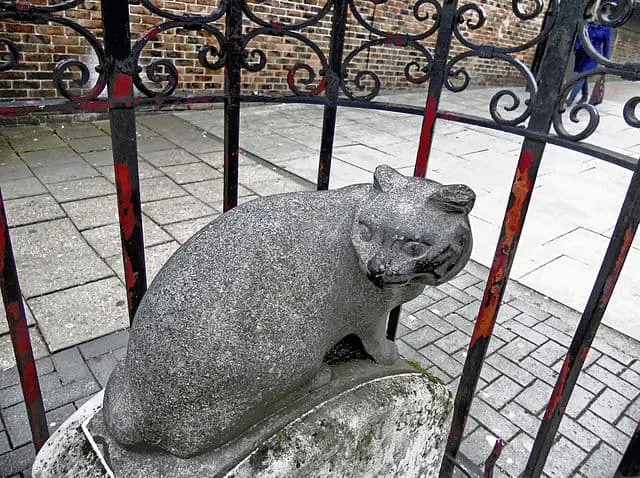A famous quote attributed to Nan Porter exclaims that “If cats could talk, they wouldn’t.” While our pals who meow may decide to remain mum if presented with the power of speech, the proverbial cat certainly hasn’t got the tongues of two statues that honor famous felines!
The sculptures are part of the Talking Statues project, which began in 2013 with speaking sculptures in Copenhagen, Denmark, and most recently gave the gift of verbal expression to a series of well-known New York City statues, including Balto, the hero sled dog. Visitors to London’s capital city are invited to hear the feline form of Hodge the cat in downtown London, and Dick Whittington’s cat, who says hello to sightseers in Highgate Hill.
The Story of Hodge

By Jim Linwood – Flickr, CC BY 2.0, https://commons.wikimedia.org/w/index.php?curid=29098241
Perched on a pedestal outside the home of 18th century writer Dr. Samuel Johnson, since 1997 a likeness of Hodge has watched people walk into the courtyard at 17 Gough Square in London. While there are statues in honor of the creator of the first English dictionary across from the place of his birth at Lichfield’s market Square as well as near St. Clement Dan’s church in London, a depiction of one of the cats he so loved was chosen to greet tourists visiting his townhouse. Placed next to Hodge is a sculpted shucked oyster, a treat which Johnson himself would purchase for his purring pals.
The bronze image of the black cat proudly stands atop a plaque which bears his favorite human’s most famous quote: “When a man is tired of London he is tired of life; for there is in London all that life can afford.” Today the voice of British actor/TV personality Nicholas Parsons tells Hodge’s tale to the public.
Dick Whittington’s Cat

Photo By Duncan Harris from Nottingham, UK – Dick Whittington’s Cat, CC BY 2.0, https://commons.wikimedia.org/w/index.php?curid=21254552
Since the early 1600s, stories have been spun about former Lord Mayor of London Richard Whittington and a cat who changed the course of his fate, but the tale appears to be a tall one. One version of the legend states that, as a poor orphan boy, Whittington set off to live in London, where he felt he might prosper. Life in England’s capital proved to be just as bleak as before, and although he had a roof over his head thanks to the Fitzwarren family who took him in, at night he had to contend with mice and rats that scurried over his bed. He solved his sleeping problem by going to market and purchasing a cat for one penny.
Young Whittington could once again visit the Land of Nod with help from his feline friend. However, when a ship owned by Fitzwarren was set to sail to a foreign land and all the servants in the household gave personal items to be sold so they could make extra money, all Whittington had in his possession was his cat. Giving up his cat, and in so doing his chances of a good night’s sleep, Dick Whittington decided to leave London. However, as he headed back to his original home, he thought he heard church bells ringing out a message: “Turn again Dick Whittington, Three times Lord Mayor of London.”
Returning to the Fitzwarren home, he later discovered that his purring pal had made him prosperous. In the far away land of Barbary that country’s royal palace was being overrun by rats, until the Fitzwarren ship arrived. The captain presented to the king Whittington’s cat, who proceeded to eradicate the royal family’s rodent problem. Thrilled at the hunting skill of the cat, the king offered gold and precious jewels to be given to Dick Whittington in exchange for the cunning kitty.
Although only a fable that surrounds the life of a real man (Richard Whittington was indeed wealthy and served as the Lord Mayor of London three times), the cat — who has become a beloved part of British folklore– has been given a life of sorts in the form of a stone figure which has crouched in London’s Highgate Hill since 1964. Today the cat’s story is explained to passers by thanks to the voice of British comedian/actress Helen Lederer (TV viewers may remember her as Catriona in the classic comedy series Absolutely Fabulous).
How to Listen to Hodge and Dick Whittington’s Cat
Tourists who visit any of London’s talking statues need simply scan the QR code with their smartphone by the corresponding sculpture to receive a call from Hodge, Dick Whittington’s cat, or other famous figures, such as Sherlock Holmes on Baker Street, Williams Shakespeare at The British Library, or Queen Victoria, either at Blackfriars Bridge or Kensington Palace. A downloadable map of London’s talking statues is available at www.talkingstatueslondon.co.uk.
- Tyler Bass Fans Donate to Cat Adoption Group - January 24, 2024
- Saint Gertrude of Nivelles, Patron Saint of Cats - January 19, 2024
- Offensive Tackle Daniel Faalele’s Defensive Play for Animal Rights - December 27, 2023
